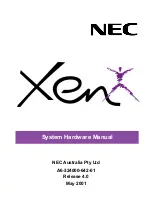
w w w . t e c h n i c o l o r . c o m / m c s
Page 64
The EPG is created in such a way that it provides the viewer with what appears to be an auto-
scrolling channel listing. It is essentially a dynamic MPEG video stream made up of still images
of the current programming. It moves down the list of assigned channels every 2.5 seconds,
creating a constant cycle, showing nine channels at a time. As such, the guide is not interactive,
so the viewer must manually tune to their channel of choice.
If the number of channels in the EPG fits in one screen (nine or less) the channel listing will not
scroll. This permits the installer to have multiple cards generating a different EPG channel
listing nine channels each. This will create the user experience that channeling up or down will
page up or down nine channels in the guide.
The EPG can also convert the DIRECTV guide information into PSIP guide information that is
decodable by many televisions. PSIP permits the channel number to be remapped, the channel
name can be displayed, the current time displayed, and the current and next program titles
displayed.
To generate PSIP guide information, the last two numbers for each channel must list the
QAM6 chassis number and QAM6 destination port number. This information is automatically
filled in when EpgLoad is clicked. To disable PSIP guide generation for a channel, set the port
number to -1. If the DestIP is a valid IP address but the DestPort is 0, then the EPG channel is
disabled but PSIP guide generation is still enabled. This makes it possible to have one card
provide PSIP data and a separate card provide guide only.
Different TVs may interpret and display PSIP data differently. It is recommended to test PSIP
operations prior to installation.
It is possible to add non-DIRECTV channels to the EPG. This is done by adding an entry where
instead of a DIRECTV channel number, the capital letter ‘N’ appears followed by the channel
name, and program information separated by underscore characters.
For example:
10-1 NLobby_The_lobby_channel 1 17
Each channel in the EPG is comprised of a still image and it can take up to 10 seconds to
produce the image for every channel being offered when the EPG is first loaded. For
example, a location offering a list of 18 channels can expect to wait up to 3 minutes for a first-
time EPG configuration.
Due to the combination of the auto-scroll programming and the constant addition of new
channels, you can expect the EPG to exhibit some odd behavior during the initial image
creation. It may appear to skip around at random, but it can be expected to settle back into a
normal operational state once it has finished generating all the necessary images.
The EPG is a video-only channel, and you cannot set audio to play in the background.
















































